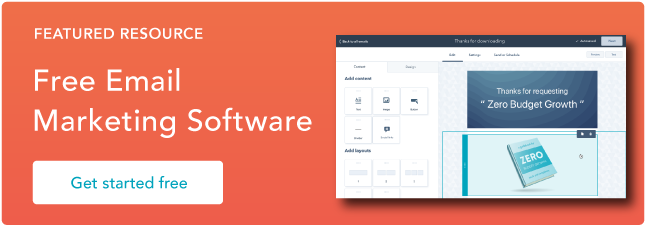Back in September 2021, the announcement of Apple’s iOS 15 data privacy changes triggered a mass hysteria among email marketers, with some even proclaiming that email marketing as we know it could come to an end.

Considering that Apple Mail and Apple mobile devices make up over 35% of the global email provider market share, those fears didn’t seem too far-fetched.
But the question remains – were these fears well-founded or were they false alarms?
Now that enough time has passed to see the impact of data privacy changes, I surveyed 300 email marketers to understand how iOS 15 and GDPR changes have affected their marketing strategies and the steps they took to adapt.
The Impact of Data Privacy Changes
Change can be scary for all of us, but when that change includes reduced visibility into email analytics, it's no surprise that email marketers were shaking in their boots when iOS15 was announced.
Surprisingly, my survey shows that the changes, while definitely impactful, were not all bad.
While two-thirds of email marketers surveyed report a moderate-to-significant impact on their email marketing strategy, whether the impact was positive, neutral, or negative, is not as clear-cut as you might assume.
 For starters, 47% of email marketers say the impact of data privacy changes was neutral on their email marketing strategy. Admittedly, 29% said the changes had a negative impact, but 24% said the contrary, claiming data privacy changes had a positive impact on their marketing strategy.
For starters, 47% of email marketers say the impact of data privacy changes was neutral on their email marketing strategy. Admittedly, 29% said the changes had a negative impact, but 24% said the contrary, claiming data privacy changes had a positive impact on their marketing strategy.
How is this possible?
To answer this, let's break down our survey data on the specific ways data privacy changes affected email marketers, and the strategies they took to adapt.
This will help us understand how some marketers made the most out of the situation and came out on top, while others weren’t able to keep up.
How Are Data Privacy Changes Affecting Email Marketing Strategies?
In the survey, I found that 65% of email marketers say they’ve been impacted by both Apple’s iOS 15 updates and GDPR.
I also asked them to share how their email marketing strategy has been affected by each, and interestingly enough, the results were very similar.
Email marketers in both camps were most impacted by the same factors, in the same order:
 So what can we take away from this?
So what can we take away from this?
For one, these changes have a similar impact whether you are affected by Apple iOS15, GDPR, or both.
More importantly, data privacy changes clearly have a meaningful impact on certain functions that have been core to email marketers' jobs.
With location-based targeting, click-through rates, open rates, and A/B testing taking a hit, many email marketers have no choice but to adapt. So let’s explore how exactly they did that.
4 Ways Email Marketers Are Adapting to Data Privacy Changes
After the initial panic, email marketers began finding creative ways to reach their target audience and measure the impact of their marketing efforts. These are the most popular strategies they used:

1. Prioritizing Different KPIs
At #1, 62% of impacted email marketers started prioritizing different KPIs to measure the effectiveness of their marketing efforts.
To HubSpotters, this isn't surprising. In fact, it's one of the first strategies our own email team used when navigating the changes.
So let’s take a closer look at which KPIs became more and less important in a post-iOS15 and GDPR world.
The KPI hit the hardest by iOS 15 is email open rates. With the update, users can prevent email marketers from seeing when and if they opened a marketing email.
But don’t worry, this just means it’s time to turn to other KPIs like clicks, click-through rates, web traffic, click maps, unsubscribe rates, and audience surveys:
Clicks, Click Rate, and Clickthrough Rate
Ultimately, KPIs like clicks and click-through rates can tell you how engaging your content is. And, aside from those metrics, features like click maps, let you see exactly where people are clicking in your email, offering you a glimpse of what portions of your email are most (and least) engaging.
In a previous blog post, Jordan Pritikin, who leads HubSpot's Email and Growth Marketing teams, similarly explained, "[Focusing on clicks, click rates, and conversions] is the right course of action. Looking at clicks and conversions is much more closely tied to how your database is engaging with your email programs,"
Website Traffic and Leads
For email marketers, engagement isn't their only goal. For example, while HubSpot's acquisition team might send emails with goals of landing page conversion, our Blog team sends emails filled with blog posts to encourage traffic to our blog.
That's why website traffic and even conversions from your marketing emails can be tracked when sending through software like HubSpot. High email traffic indicates your email content is succeeding at getting recipients to visit your site. Meanwhile, high lead counts from emails indicate that you've successfully nurtured contacts to a landing page.
Unsubscribe and Spam Rates
Spiking unsubscribe rates can indicate that the content you are sending, or the frequency, has caused you to lose more of your audience than usual. On the other hand, a low unsubscribe rate means you are retaining your readers.
Similarly, getting one spam report here and there doesn't necessarily mean everyone dislikes your content – but seeing a rise in spam rates could mean that subscribers suddenly see no value in your content, find it annoying, or aren't getting what they signed up for.
Open Rates (with a Grain of Salt)
As Pritikin wrote, "Open rates will not be going away. They will just be -- different."
And, while you could say, "We will never look at open rates again," you could still be doing yourself a disservice by ignoring them completely. At this point, you should continue to monitor your average open rate (and how it changes). This way, you can create a new Open Rate benchmark for your team that's adjusted to meet new tracking standards.
While an adjusted open rate benchmark won't be 100% accurate, it will still tell you when you've successfully gotten a large chunk of subscribers to open an email, and when your subject line might need work.
HubSpot’s Adjusted Open Rate feature can help you achieve a better estimate of email opens. The features uses the following formula:
Adjusted open rate = Unique reliable opens / (Unique delivered - Unique unreliable opens)
Adjusted open rate can also be used as backup evidence if you're using all of your KPIs to determine the success of a new strategy or email campaign.
Surveys or Feedback Forms
Each time the HubSpot Blog tests a major email experiment or a new type of content in our emails, we try to include a feedback survey where readers can let us know what they thought. Meanwhile, The Hustle and other HubSpot emails offer a rating scale where you can rate your email experience and give feedback.
While this doesn't always lead to make-or-break data, surveying, polling, or seeking feedback from your audience can also be a great way to understand their interests and what they want to see more or less of in the future.
2. Gaining User Data From Other Sources
The second most popular strategy is leveraging user data from sources unaffected by data privacy changes, used by 52% of impacted email marketers.
An example of this would be analyzing email data coming from non-Apple users, which can still give you a clear idea of an email’s open rate, among other metrics.
3. Expanding on Messaging Channels
Coming in at #3, 37% of impacted email marketers started leveraging channels other than email marketing, like SMS.
Before you scoff at the idea, consider these facts. 3.8 billion people currently carry a cell phone with them everywhere they go and 48 million opted in to receive marketing messages over text in 2020.
Still not convinced? Here’s the kicker – SMS has a 98% open rate, while our survey shows that only 3% of marketing emails have an open rate above 50%. Furthermore, 65% of marketing emails have an open rate that falls in the 16-35% range, significantly lower than the open rate of SMS correspondences.
If you’re ready to add SMS to your marketing strategy, you can find 30 SMS templates here.
But there are plenty of channels marketers can lean on. In our recent media planning survey, we found that while email marketing is the most popular channel marketers leverage, it comes in #3 for ROI, and doesn’t see high engagement.
Paid social media content, however, has the highest ROI and engagement of any marketing channel, followed by organic social media content at #2 for both ROI and engagement. Organic search (SEO) also has comparable ROI and engagement levels when compared to email marketing.

4. Improving Email Deliverability
Lastly, 28% of email marketers responded to privacy changes by focusing on improving email deliverability.
That means leveraging strategies like maintaining a healthy email list, providing easy unsubscribe options, personalizing emails, using engaging subject lines and preview text, and making sure your emails and mailing list are GDPR compliant.
While this data on how email marketers adapted to privacy changes tells us which strategies are most popular, we also want to know which are most effective.
Want more tips and tricks for navigating iOS 15? Check out this video:
The Email Strategy Pivots That Help Most
So let’s compare these strategies by splitting our data by those who say privacy changes had a positive impact on their email marketing strategy vs. those who report a negative impact:
 Looking at the data above, we can see that those who say the data privacy changes had a positive impact on their email marketing strategy are:
Looking at the data above, we can see that those who say the data privacy changes had a positive impact on their email marketing strategy are:
- 9% more likely to prioritize different KPIs to measure the effectiveness of email marketing
- 7% more likely to leverage channels other than email for marketing
- 21% less likely to focus on improving email deliverability
- 5% less likely to leverage user data from sources unaffected by data privacy changes.
While the differences between these groups can give you an idea of where to get started, remember that these strategies can all be effective, and every situation is unique.
For example, if a majority of your customers use Apple mail, it may not be as effective to study email data of the handful of your clients who use Gmail or Outlook.
Navigating Email Privacy Impacts
All in all, email privacy protection is not even close to "the end of the world" for email marketers. That said, it does and will continue to require some creative pivoting.
Like any major online marketing strategy, email marketers must learn how to adapt to a changing world that continues to prioritize consumer privacy. And, although privacy features will continue to evolve and pose new challenges for brands, companies that navigate them successfully will still be able to create experiences that feel personalized, memorable, and – importantly – secure for online audiences.
Ultimately, that's good for everyone.
Want to learn more about Apple iOS 15's email privacy protection updates? Get the backstory here, learn how HubSpot's email team has responded, or this Community thread if you're a HubSpot user.
Looking to find a tool that offers transparent email data estimates and can help you optimize your messaging for the most engagement possible? Check out HubSpot's own Email tools








![Creating an HTML Email: The Design Guide You Need [+ Free Templates]](https://www.hubspot.com/hubfs/html%20design.png)


![30 Brilliant Marketing Email Campaign Examples [+ Template]](https://www.hubspot.com/hubfs/email-marketing-examples_29.webp)